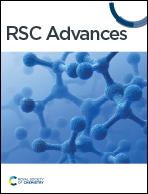Fabrication and characterization of a novel magnetic nanostructure based on pectin–cellulose hydrogel for in vitro hyperthermia during cancer therapy
Abstract
Herein, a new magnetic nanobiocomposite based on a synthesized cross-linked pectin–cellulose hydrogel (cross-linked Pec–Cel hydrogel) substrate was designed and synthesized. The formation of the cross-linked Pec–Cel hydrogel with a calcium chloride agent and its magnetization process caused a new and efficient magnetic nanobiocomposite. Several spectral and analytical techniques, including FTIR, SEM, VSM, TGA, XRD, and EDX analyses, were performed to confirm and characterize the structural features of the magnetic cross-linked pectin–cellulose hydrogel nanobiocomposite (magnetic cross-linked Pec–Cel hydrogel nanobiocomposite). Based on SEM images, prepared Fe3O4 magnetic nanoparticles (MNPs) were uniformly dispersed in the Pec–Cel hydrogel context, representing an average particle size between 50.0 and 60.0 nm. The XRD pattern also confirms the crystallinity of the magnetic nanobiocomposite. All constituent elements and their distribution have been depicted in the EDX analysis of the magnetic nanobiocomposite. VSM curves confirmed the superparamagnetic behavior of Fe3O4 MNPs and the magnetic nanobiocomposite with a saturation magnetization of 77.31 emu g−1 and 48.80 emu g−1, respectively. The thermal stability of the nanobiocomposite was authenticated to ca. 800 °C based on the TGA thermogram. Apart from analyzing the structural properties of the magnetic cross-linked Pec–Cel hydrogel nanobiocomposite, different concentrations (0.5 mg mL−1, 1.0 mg mL−1, 2.0 mg mL−1, 5.0 mg mL−1, and 10.0 mg mL−1) of this new magnetic nanostructure were exposed to an alternating magnetic field (AMF) at different frequencies (100.0 MHz, 200.0 MHz, 300.0 MHz, and 400.0 MHz) to evaluate its capacity for an in vitro hyperthermia process; in addition, the highest specific absorption rate (126.0 W g−1) was obtained by the least magnetic nanobiocomposite concentration (0.5 mg mL−1).



 Please wait while we load your content...
Please wait while we load your content...